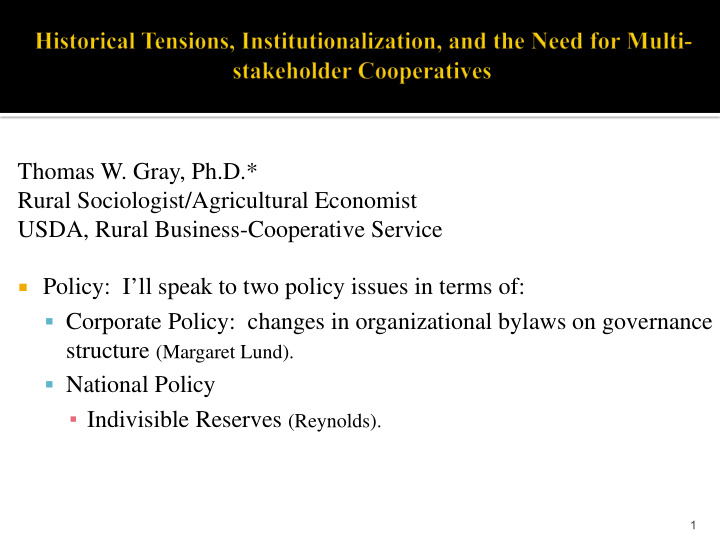



Thomas W. Gray, Ph.D.* Rural Sociologist/Agricultural Economist USDA, Rural Business-Cooperative Service ¡ Policy: I’ll speak to two policy issues in terms of: § Corporate Policy: changes in organizational bylaws on governance structure (Margaret Lund). § National Policy ▪ Indivisible Reserves (Reynolds). 1
Methods: This is a conceptual/theoretical/historical piece so there isn’t really any methods in an empiricist sense, though there is literature to support this discussion. Problems 1) Historically agricultural cooperatives have been formed to obtain a) needed products/services [not available in the market place], b) to compete against market concentration/power, and c) to provide democratic governance for farmers. 2) In order to compete with IOFs agricultural cooperatives have had to increase scale over time, but to such a degree, they are sometimes dismissed “just like any “other” business.” 3) This is in fact a criticism about the dilution and loss of local/ democratic responsiveness , and where the business/economics aspects have become much more predominant. 4) These problems have been compounded by loss of funding for education, research, technical assistance due to budget cuts, co-op drops (Torgerson et al; Gray; Lund; Mooney). 2
¡ The predominant business form in the economic context of cooperatives is the IOF. ¡ IOFs seek to make a return on money , simply put, one starts with a pile of money, and then offers some kind of service or product to get more money. ¡ Co-op members seek a service . There is some need, a product or service is offered to meet the need, a financial margin is obtained to continue the service thru time. ¡ Both must make a margin over costs. ¡ Internal logic of IOFs: return on investment, roi ¡ Internal logic of cooperative: use (Gray). 3
¡ Cooperative Principles: ¡ The User-Owner Principle ¡ The User-Control Principle ¡ The User-Benefits Principle : ¡ (Dunn, Abrahamson). 4
¡ Because of their dual natures (democracy versus business ,) they have various agencies that are in tension with each other. ¡ Use, participation, and self-governance // Efficiency, economic performance, roi—(are not mutually exclusive, they interpenetrate each other). ¡ And these internal tensions are in dynamic relation to the external context. ¡ And they can shift in terms of which end is predominant due to such pressures, in the context, as economic conditions, technological changes, changes in the structure of agriculture, globalization, social movements, among others (Gray; Dimaggio, Jorge & Herman; Mooney; Fairbarin). 5
¡ Three external tensions are considered here. ¡ 1) Participation and democracy//Efficiency and Capital investment . ¡ 2) Localism//Geographic expansion . ¡ 3) Production//Consumption ¡ (Mooney & Gray; Dimaggio, Jorge & Herman; Mooney, Gray) . 6
Multi-stakeholder cooperatives If there are at least two classes of members; it’s considered a multi- stakeholder co-op, each group has seats on the board , (worker vs community). (Leviten-Reid, Fairbarin). Criticisms: Decision making is cumbersome (takes more time). Predictions co-ops will fragment to IOF firm or close. (Lindsay, Hems) Hems, Munker.) Leviten-Reid, Fairbarin (2011) argue that members join not only for access to market, products, and/or service but for socio-economic, community welfare and ecological goals and that these goals often result in greater member involvement and ultimately greater o rganizational resilience (Lund). Prevalent in Quebec, Ontario and Italy, growing in numbers in U.S. 7
¡ Weaver Street Market, (Hillsborough, North Carolina ( consumers and employees ) est. 1988. (30 years ago) ¡ Oklahoma Food Cooperative, Oklahoma City, Oklahoma (Consumers and producers are members) est. 2002 (16 years ago). Black Star Co-op and Brewery , Austin, Texas. est. 2010. (8 years . (Consumer, workers, community supporters as members). 8
9
10
11
¡ Corporate bylaw changes: In Multi-stakeholder cooperatives , governance provisions are typically provided by allotting board of director seats according to how central the stakeholder stake is in the organization. ¡ seeking some approximate balance of interest ensuring each stake has a voice . (Margaret Lund). 12
Indivisible reserves have three purposes : 1) reducing incentives for demutualization , 2) distributing funds for cooperative development in event of closure, 3) providing permanent capital to strengthen solvency (Reynolds). In cases of acquisitions by IOFs and/or conversion to IOFs, these funds provide an disincentive to such actions in that they can not pass to members nor to an acquiring investment firm. In the event of cooperative closures, indivisible reserves must stay in the cooperative sector , either going to a national fund for cooperative development, or to a federation of cooperatives (Giszpenc). In the U.S, they would possibly go to State Cooperative Councils, depending on location of the cooperative. Funds provide stability for organization. These funds might provide for research, education, and technical assistance that had previously been lost to budget cuts, cooperative cutbacks. 13
¡ Pre-history : We may be in a kind of pre-history with many of these organizations. They may be still fairly fragile in what Gar Alperovitz (2013) suggests is a pre-history. ¡ They may gain greater ascendance if current socio-economic (e.g. inequality) and ecological conditions (e.g. climate change) continue. ¡ ¡ By internalizing within an organization with inclusive democratic voice and use characteristics, various social, economic and ecological needs might be more holistically addressed 14
Recommend
More recommend